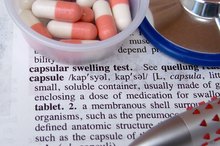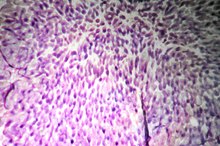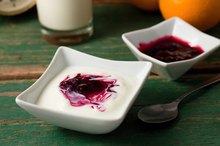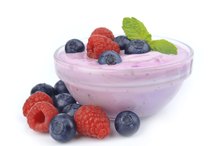What does fact checked mean?
At Healthfully, we strive to deliver objective content that is accurate and up-to-date. Our team periodically reviews articles in order to ensure content quality. The sources cited below consist of evidence from peer-reviewed journals, prominent medical organizations, academic associations, and government data.
- Nestle Nutrition Workshop Series; Functional Fermented Milk Products; O. Brunser, et al.
- Nestle Nutrition Workshop Series; Functional Fermented Milk Products; O. Brunser, et al.
- Journal of Chromatography; Quantification of Bovine Casein Fractions by Direct Chromatographic Analysis of Milk; Ivan Bonizzi, et al.
- Journal of Chromatography; Quantification of Bovine Casein Fractions by Direct Chromatographic Analysis of Milk; Ivan Bonizzi, et al.
- Journal of Dairy Science; Effect of Kefir Grains on Proteolysis of Major Milk Proteins; I.M. Ferreira, et al.
- Journal of Dairy Science; Effect of Kefir Grains on Proteolysis of Major Milk Proteins; I.M. Ferreira, et al.
- Journal of Dairy Science; Lactobacillus Helveticus -- A Thermophilic Dairy Starter Related to Gut Bacteria; Lydia Slattery, et al.
- Journal of Dairy Science; Lactobacillus Helveticus -- A Thermophilic Dairy Starter Related to Gut Bacteria; Lydia Slattery, et al.
- Bioresource Technology; Purification and Kinetics of Two Novel Thermophilic Extracellular Proteases from Lactobacillus Helveticus, from Kefir with Possible Biotechnological Interest; Krystalenia Valasaki, et al.
- Bioresource Technology; Purification and Kinetics of Two Novel Thermophilic Extracellular Proteases from Lactobacillus Helveticus, from Kefir with Possible Biotechnological Interest; Krystalenia Valasaki, et al.
- Biofactors; Effects of an Exopolysaccharide (Kefiran) on Lipids, Blood Pressure, Blood Glucose, and Constipation; Hiroaki Maeda, et al.
- Biofactors; Effects of an Exopolysaccharide (Kefiran) on Lipids, Blood Pressure, Blood Glucose, and Constipation; Hiroaki Maeda, et al.
- Cytotechnology; Fermented Milk, Kefram-Kefir Enhances Glucose Uptake Into Insulin-Responsive Muscle Cells; Kiichiro Teruya, et al.
- Cytotechnology; Fermented Milk, Kefram-Kefir Enhances Glucose Uptake Into Insulin-Responsive Muscle Cells; Kiichiro Teruya, et al.
The information contained on this site is for informational purposes only, and should not be used as a substitute for the advice of a professional health care provider. Please check with the appropriate physician regarding health questions and concerns. Although we strive to deliver accurate and up-to-date information, no guarantee to that effect is made.
Kefir remains a popular fermented milk beverage, despite the increasingly competitive beverage market. Many people drink kefir for its alleged health benefits, according to a 2007 report in the “Nestle Nutrition Workshop Series.” The bacteria in kefir produce lactic acid by fermenting lactose. Kefir contains many kinds of enzymes that underlie this process. Talk to your doctor before ingesting large amounts of kefir.
What Kefir Enzymes Do
Casein plays a critical role in turning milk into kefir. Nearly 80 percent of the protein in milk comes from four members of the casein family, according to January 2009 review in the “Journal of Chromatography.” These substances include alpha-casein, kappa-casein and two types of beta-casein. A study published in the January 2010 issue of the “Journal of Dairy Science” showed that the enzymes present in kefir break down milk caseins. The resulting substances -- known as peptides -- have a broad range of health-promoting effects. They can, for example, bolster your immune system.
- Casein plays a critical role in turning milk into kefir.
- Nearly 80 percent of the protein in milk comes from four members of the casein family, according to January 2009 review in the “Journal of Chromatography.”
Lmm-Protease-Lh and Hmm-Protease-Lh
Does Kefir Milk Have More Benefits Than Whey Protein?
Learn More
Manufacturers often use Lactobacillus helveticus to ferment dairy products such as cheese and kefir. This bacteria improves the flavor of cheddar cheese, according to an October 2010 review in the “Journal of Dairy Science.” The enzymes mediating these effects remain unknown. A study presented in the September 2008 edition of “Bioresource Technology” purified Lactobacillus helveticus samples to identify the enzymes present in the bacteria 45. The scientists found two unique substances known as Lmm-protease-Lh and Hmm-protease-Lh. The identification of these enzymes could allow the production of amino acids from the proteins contained in meat, fish and whey.
- Manufacturers often use Lactobacillus helveticus to ferment dairy products such as cheese and kefir.
- The identification of these enzymes could allow the production of amino acids from the proteins contained in meat, fish and whey.
Cell-Wall-Bound Proteinase
Dairy producers use lactic starters such as bacteria from the Lactobacillus family to manufacture yogurt and kefir 4. These substances break down the casein in milk and begin the conversion of milk to fermented products 1. An enzyme from the cell-wall-bound proteinase group mediates this process. Another member of this family might appear in kefir. An investigation published in the June 2006 issue of “Biotechnology and Biotechnological Equipment” tested this hypothesis in Lactobacillus kefir -- a strain commonly found in kefir. The researchers identified at least one cell-wall-bound proteinase based on its ability to break down beta-casein and not alpha-casein.
- Dairy producers use lactic starters such as bacteria from the Lactobacillus family to manufacture yogurt and kefir 4.
- The researchers identified at least one cell-wall-bound proteinase based on its ability to break down beta-casein and not alpha-casein.
Phosphatidylinositol 3-Kinases
Kefir And Magnesium
Learn More
It remains unknown how kefir achieves its alleged health effects. Byproducts of kefir -- known as kefiran -- lower blood pressure, according to a 2004 report in “Biofactors.” Kefir itself might enhance athletic performance. An experiment described in the November 2002 edition of “Cytotechnology” looked at kefir’s effect on glucose uptake 8. The researchers exposed cultured muscle cells to kefir during a single testing session. This treatment increased the uptake of glucose -- an effect known to enhance athletic abilities. Kefir-induced activation of phosphatidylinositol 3-kinase appeared to mediate this effect. This family of enzymes plays an important role in cell growth.
- It remains unknown how kefir achieves its alleged health effects.
- This treatment increased the uptake of glucose -- an effect known to enhance athletic abilities.
Related Articles
References
- Nestle Nutrition Workshop Series; Functional Fermented Milk Products; O. Brunser, et al.
- Journal of Chromatography; Quantification of Bovine Casein Fractions by Direct Chromatographic Analysis of Milk; Ivan Bonizzi, et al.
- Journal of Dairy Science; Effect of Kefir Grains on Proteolysis of Major Milk Proteins; I.M. Ferreira, et al.
- Journal of Dairy Science; Lactobacillus Helveticus -- A Thermophilic Dairy Starter Related to Gut Bacteria; Lydia Slattery, et al.
- Bioresource Technology; Purification and Kinetics of Two Novel Thermophilic Extracellular Proteases from Lactobacillus Helveticus, from Kefir with Possible Biotechnological Interest; Krystalenia Valasaki, et al.
- Cheese; General Aspects; P.F. Fox
- Biofactors; Effects of an Exopolysaccharide (Kefiran) on Lipids, Blood Pressure, Blood Glucose, and Constipation; Hiroaki Maeda, et al.
- Cytotechnology; Fermented Milk, Kefram-Kefir Enhances Glucose Uptake Into Insulin-Responsive Muscle Cells; Kiichiro Teruya, et al.
- Prado M, et al. Milk kefir: composition, microbial cultures, biological activities, and related products. Frontiers in Microbiology. 30 Oct 2015. DOI: 10.3389/fmicb.2015.01177
- Today's Dietitian. Milk fat does a body good. Sept 2012.
- Harvard Health. Fermented foods can add depth to your diet. July 2018.
- Turan, I, et al. Effects of a kefir supplement on symptoms, colonic transit, and bowel satisfaction score in patients with chronic constipation: A pilot study. Turkish Journal of Gastroenterology. 2014; 25: 650-656. DOI: 10.5152/tjg.2014.6990
- Hertzler SR, Clancy SM. Kefir improves lactose digestion and tolerance in adults with lactose maldigestion. J Am Diet Assoc. 2003 May;103(5):582-7. doi: 10.1053/jada.2003.50111.
- Liu, Y., Alookaran, J. J., & Rhoads, J. M. (2018). Probiotics in Autoimmune and Inflammatory Disorders. Nutrients, 10(10), 1537. https://doi.org/10.3390/nu10101537
- Su GL, Ko CW, Bercik P, Falck-Ytter Y, et al. AGA Clinical Practice Guidelines on the Role of Probiotics in the Management of Gastrointestinal Disorders. Gastroenterology. 2020 Aug;159(2):697-705. doi: 10.1053/j.gastro.2020.05.059.
- Rafie N, Golpour Hamedani S, Ghiasvand R, Miraghajani M. Kefir and Cancer: A Systematic Review of Literatures. Arch Iran Med. 2015 Dec;18(12):852-7.
- Food Standards Australia New Zealand. Coordinated survey of alcohol content and labelling of fermented soft drinks – Summary. August 2019.
Writer Bio
Tomas Linnaeus is a psychologist, scientist and activist. Extensively trained in neuroscience, he has been published in professional journals like "Physiology and Behavior," "Journal of Sleep Research" and "Neuroscience and Biobehavioral Reviews." Linnaeus has been writing for over 25 years and received a doctoral degree in psychology from Bowling Green State University.









